Bronze Bushings & Bearings
Our
Bronze Bushing stock material is available as C93200 Standard Stocked Sleeve Bearings, Sintered Bronze Bearings and is also available as Custom Made to Order plain bearings. The purpose of the bearings is to protect the moving parts from wear and shock loads. These bronze bearings have no rolling elements, unlike roller bearings.
Sintered Bronze Bearings are unique in that they start as a powder and in most cases do not require any additional lubrication.
Standard Stocked bronze bushings (CB Bushings) are offered in C93200 Bearing Bronze (SAE 660). We also have Standard Stocked Bushings available in SAE 841 Sintered Bronze. Between these two product lines, we feature over 1,000 different bronze bushing sizes available to ship from stock. These standard parts provide an off-the-shelf economy for many different applications.
We also know that sometimes a Standard Bushing will not work. That is why we also offer our
quote service for made-to-order bronze bushings that are "Machined to Print" or "Made from Sample" parts. We welcome drawings in a number of different formats, such as; .pdf, Word, .jpeg's or CAD files to meet our customers’ needs.
Depending on the type of Bronze Bushing needed, we have the ability to use many different casting methods,
alloys, and sizes to meet your requirements. The most common alloys used for customer bronze bushings are C93200, C95400, and C86300. But we have made bushings from just about every type of Bronze on the market. The alloy you choose will largely depend on the high load capacity, high speeds, axial loads, and operating temperature.
Why Bronze Bushings?
There are so many different types of bushings available - including polyurethane plastic for bushings that boast about their inability to rust. However, nothing can compare to what is offered with bronze bushings.
They are hard, strong, and are safe from rusting, too. Of course, we don't want to forget to mention their incredibly long lifespans.
Benefits of Bronze Bushings and Bearings
As we have mentioned, plastic bushings are actually used quite often in applications because they don’t rust. But did you know that bronze bushings and bearings don’t rust either? They are actually corrosion-resistant. So, when it comes to piecing together something, whether an automobile or a home appliance, would you feel better if it were made with plastic or a sturdy metal?
There are several benefits that come with using bronze bushing stock materials, including:
- Long-lasting
- Excellent resistance to friction and wear over time
- Can easily be used at high temperatures without changing shape or deforming
- Hard and durable, making them less likely to break or change shape under pressure
- Corrosion-resistant
- Available in many alloys and compositions
Common Applications of Bronze Bushings & Bearings
You will find bronze bushings and bearings used, one way or another, in every industry. This means creating an actual list of uses that is not exhaustive just isn’t possible. But just to name a few places where you may find these bronze component parts:
- Sleeve Bearing
- Engines
- Bicycles
- Fishing reels
- Hydraulic cylinders
- Stage lighting
- Medical and dental tools
- Printer rollers
- Surveillance systems
- Kitchen appliances
- Escalators
- ATMs
Typically there are 3 Standard Types of Bronze Bushings
Bronze sleeve bearings are a simple solution to ensure movement between two parts - with minimal friction and vibration. They can handle heavy loads and high temperatures with minimal impact. The result? You can rely on self-lubricating sleeve bearings under heavy use and for extended time. These low cost, low noise, minimal maintenance yet high functioning bronze sleeve bearings are the top choice for many.
- Flange Bearing (Double Flange also)
Flange bearings are self-aligning bearings - and they are contained inside their own housing unit. One part of the housing is bolted to the unit while the other is left free. This allows the bearing to rotate within a contained area.
Flange bearings are usually used for light duty, rather than heavy duty needs. That’s why you will normally find them in things like conveyors, belt drive, food processing machines, and so forth.
- Thrust Bearing (also called a Thrust Washer)
Thrust bearings are also referred to as rotary bearings. They are designed to rotate along with the moving parts of the unit they are used in. In other words, when the parts begin to rotate, it is the thrust bearing that they glide along. Thrust bearings are popular because they are not only highly reliable, easy to mount/dismount, and have a high load capacity, but they can also withstand harsh environments. You can often find thrust bearings in automotive, marine, and aerospace industries. They are often used for things like gears due to their smooth movements and low noise.
Each type is available as a Plain, Grooved (Oil or Grease) and/or Graphite Plugged.
The Power of Bronze
If you find you are interested in metal bushings or bearings rather than plastic, but you aren’t sure if bronze is the right metal for you, we thought that perhaps we should share a little bit about why it is a great choice for these small yet integral parts. Bronze is an extremely versatile metal with a reddish brown color that exhibits low metal-to-metal friction. It has a high melting point and a hardiness about it. Bronze can be grinded and buffed into the most precise shape for any application.
Because bronze does not contain any iron, it does not rust. If it comes in contact with certain harmful chemicals, such as chloride, however, it can corrode. Most applications do not expose the metal to any of these chemicals, making it a long-lasting option.

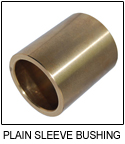 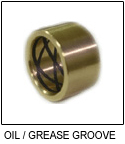 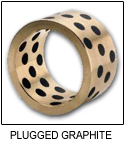
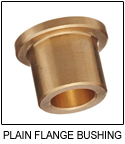 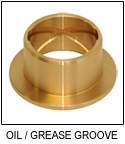 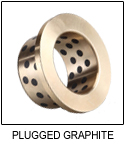
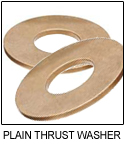 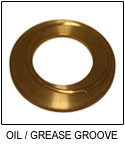 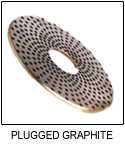
Frequently Asked Questions About Bronze Bushings & Bearings
What is the difference between a bronze bushing and a bearing?
The two words - bushing and bearing - get thrown around a lot together. Sometimes they are even used interchangeably. But while they are very similar, they do have a slight difference. Let’s take a look at why this confusion is so prevalent.
A bearing is a component piece that is decided to help two different parts move without too much friction between them. There are different designs for how this works, such as ball bearings, roller bearings, needle bearings, sleeve bearings, flange bearings, etc. Depending on what you are using the bearing for, you will choose the best design.
A bushing is a type of bearing. They are also referred to as plain bearings or sleeve bearings. It moves in a sliding motion between two moving surfaces, also reducing friction.
Does brass work just as well for bushings?
Believe it or not, bronze bushing material has become so popular due to its strength. Brass, on the other hand, just cannot compare. By nature, it tends to be a much softer metal that will easily deform and not hold its place.
Do bronze bushings rotate?
No bronze bushings do not rotate. They are shaped like a sleeve so that they may slide, not rotate. However, they do assist bearings by rotating efficiently.
Do bearings need to be lubricated?
Yes, you will absolutely want to make sure you are keeping your bearings lubricated. Not only does it deter corrosion, but it also reduces the wear and tear on the component.
The idea behind a bearing is to have a smooth flow with minimal friction between the two parts. Without proper lubrication, this isn’t always possible. The friction will heat up and the life of the bearing may dwindle.
Always keep your bearings properly lubricated.
Can these bronze bushings and bearings be used in water applications?
Yes. Different types of bronze are often used in marine applications, for example, due to their ability to be corrosion resistant - even in seawater. Constant submersion underwater will not impact the integrity of the bronze bearing.
How long does bronze last?
With minimal maintenance, bronze can easily last for hundreds of years. There are harmful chemicals that can impact the metal, but even then it has to be very severe to destroy it.
How can I learn more about bronze bushings and bearings?
If you have questions about the bronze bushings and bearings we offer and want to know whether or not they will be a great way to fulfill your need, then contact the professional and knowledgeable team at Atlas Bronze at (800) 478-0887.
|












